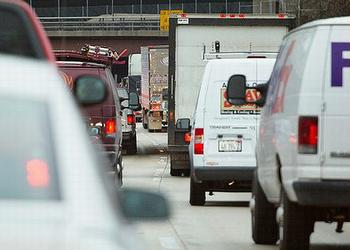
WASHINGTON, DC, March 22, 2013 (ENS) – Sometime before the end of March, the U.S. Environmental Protection Agency is expected to propose new national vehicle emissions and fuel standards by updating a program called Tier 3.
Updated Tier 3 standards would cut smog and soot, among other pollutants, by establishing new standards for light-duty vehicles and their fuels to reduce emissions of the most toxic pollutants.

The standards in this rule are expected to lead to reductions in ozone, particulate matter, nitrogen dioxide, and mobile source air toxics and impose new restrictions on the sulfur content of gasoline.
Th EPA will set forth a comprehensive approach toward regulating motor vehicles for both greenhouse gases and non-greenhouse gas pollutants, as requested by a May 2010 an official Memorandum from President Barack Obama.
The proposed Tier 3 standards will accomplish this goal by harmonizing with the California Low Emission Vehicle (LEV III) standards for non-GHGs, and by coordinating implementation with EPA’s recently-finalized GHG/fuel efficiency standards for 2017 model year and later light-duty vehicles.
EPA is also developing these standards in response to Section 202 of the Clean Air Act, which requires EPA to establish standards for motor vehicles and to revise such standards from time to time.
Timing of rulemaking The Tier 3 proposal is currently under interagency review and is projected to be signed and published this month.
The final rule must be issued by December 2013 in order to provide industry the required lead time for implementation beginning in the 2017 model year, which starts as early as January 2, 2016.
The 2017 start date is critical to achieving the harmonized 50-state vehicle program and coordinated implementation with the greenhouse standards – a key desire of the auto industry and a fundamental goal of the Tier 3 program.
Updating the Tier 3 standards is supported by state health officials, automakers, the emissions control industry, health and environmental groups, and national recreation groups.
“We write to you today on behalf of the National Association of Clean Air Agencies (NACAA) to urge you to propose the Tier 3 vehicle emissions and gasoline standards as soon as possible,” wrote the organization that represents air pollution control agencies in 43 states, the District of Columbia, four territories and 116 metropolitan areas in a letter to outgoing U.S. EPA Administrator Lisa Jackson.
“In our report, we show that the costs of cleaner vehicles and cleaner gasoline are extremely modest while the related public health and environmental benefits are substantial,” wrote NACAA. “We know of no other single air pollution control strategy that can provide emissions reductions as significant and immediate as this.”
“We’d like to see lower sulfur. That’s important to meeting the goal of cleaner emissions,” wrote NACAA, which intends to push that issue in Washington.
In their own joint letter to the EPA administrator, seven national health organizations, including the American Lung Association and the American Heart Association, wrote, “By issuing strong Tier 3 standards, and particularly the low sulfur fuel measures, you will clean up our urban parks and our national parks, ensuring that the health benefits of getting outside to recreate, exercise, and connect with nature are not compromised by poor air quality.”
Mitch Bainwol, president of the Alliance of Automobile Manufacturers, is on the record as saying that Tier 3 will establish a new threshold of tighter standards that will set the stage for the next step of emission reductions around the world.
Bainwol said the automakers in the United States will be first to develop technology that will meet the new Tier 3 standards and will be in the best position to supply product into these new expanding markets elsewhere around the world.
In January, a wide-ranging group of industry, environmental, labor, financial and science organizations, representing millions of Americans, wrote to President Obama urging him to finalize the Tier 3 vehicle emission and gasoline standards no later than December 31, 2013.
“Tailpipe and fuel standards to control smog-forming and particulate emissions from passenger vehicles are key to reducing the health impacts of poor air quality including asthma, respiratory problems, and premature death,” the group states in its joint letter.
“Completing this rule will build on the strong foundation of clean car standards that nearly double fuel efficiency and cut dangerous tailpipe pollution in half by 2025, which you achieved in your first term,” the group wrote to the President..
The Tier 3 standards are a revision to the existing Tier 2 vehicle and gasoline sulfur standards, which were published in 2000 and phased in from 2004-2010.
Tier 2 introduced an integrated way of addressing vehicle and fuel standards – a systems approach that has been replicated during the last 10 years in subsequent vehicle, engine and sulfur standards for on-road heavy-duty trucks, nonroad diesel engines and equipment, diesel locomotive and marine engines.
Copyright Environment News Service (ENS) 2013. All rights reserved.
© 2013, Environment News Service. All rights reserved. Content may be quoted only with proper attribution and a direct link to the original article. Full reproduction is prohibited.
